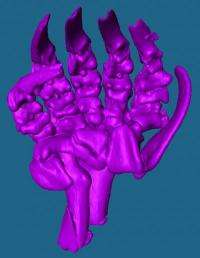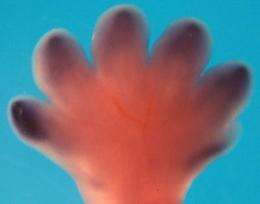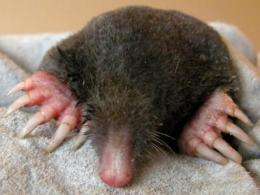How the mole got its 12 fingers

Polydactyly is a hereditary anomaly that is relatively common in both humans and animals. Moles also have additional fingers. In their case, however, the irregularity compared to the five-finger formula of land vertebrates is the norm. An international team of researchers head-ed by paleontologists from the University of Zurich has now uncovered the background to the development of the mole's extra "thumb": A bone develops in the wrist that stretches along the real thumb, giving the paw a bigger surface area for digging.
Most pawed animals have ten fingers. One of the main exceptions is the little mole: It has an extra "thumb", which it rests upon while digging and thus increases the size of its digging apparatus. Poly-dactyly – the presence of supernumerary fingers – is a phenomenon that has already been observed in various land animals in Devon and is also fairly common in humans, dogs and cats. Land verte-brates appear to possess a silent developmental program for polydactyly, which is only activated un-der certain conditions. In moles, however, polydactyly is the norm, which means the program is con-stantly activated during embryogenesis.

An international team of researchers headed by Marcelo Sánchez-Villagra, a professor of paleontolo-gy at the University of Zurich, has studied the molecular-genetic origin and development of the extra thumb in moles. As the scientists reveal in their recent article published in the journal Biology Letters, the additional thumb develops later and differently during embryogenesis than the real fingers. The studies were funded by the Swiss National Science Foundation.

Unlike the other fingers on the mole's hand, the extra thumb does not have moving joints. Instead, it consists of a single, sickle-shaped bone. Using molecular markers, the researchers can now show for the first time that it develops later than the real fingers from a transformed sesamoid bone in the wrist. In shrews, however, the mole's closest relative, the extra thumb is lacking, which confirms the re-searchers' discovery.
Male hormones linked to polydactyly
The researchers see a connection between the species-specific formation of the extra thumb in the mole and the peculiar "male" genital apparatus of female moles. In many mole species, the females have masculinized genitals and so-called "ovotestes", i.e. gonads with testicular and ovary tissue instead of normal ovaries. Androgenic steroids are known to influence bone growth, transformation and changes, as well as the transformation of tendons in joints. A high level of maternal testosterone is also thought to be one of the causes of polydactyly in humans.
Provided by University of Zurich















